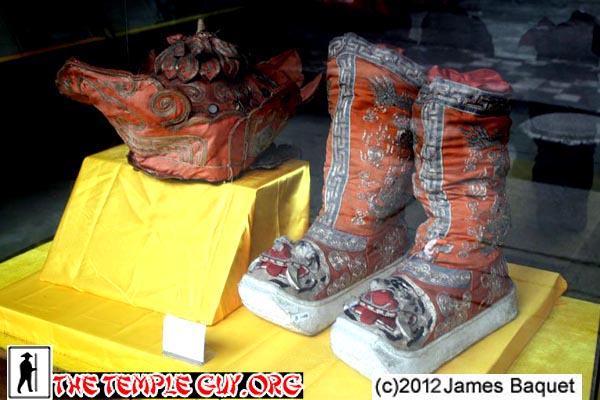(1) An Indian monk had founded the first temple on Jiuhua Shan in 401, and Huacheng Si was built on the same site in 757, so it's counted as the oldest temple here. The two oldest extant halls are from the sixteenth century, and the other two are from the nineteenth.
(2) The second hall has been turned into a museum of Jiuhua Shan's Buddhist history. The pictures were nice (meaning, I don't read much Chinese).
(3) These were somebody's hat and shoes. As the shoes are half-again as big as mine, I'm guessing they're supposed to have belonged to the Korean monk, he of the giant footprints (story on picture #5 here).
(4) Some paintings from the museum: I don't know how old the watercolor is, but it shows the temple itself as it is today, and the half-moon pond. But the pagoda isn't there, and a lot of crappy shops are.
(5) This is a view of Roushen Dian, where I went yesterday. Again, it's not the scene we see today. The Bell and Drum Towers are missing here, and the stairs don't approach like that. I don't think the ritual space is there either (but I didn't approach that way). Still, I love the image.
(6) The Korean monk believed to be Dizang, as he meditated.
(7) This is exactly how Tiantai Si felt on my first day. The hall and the little pavilion are still there, though you can't see them (or the stairs) like this.
(8) Looking from the museum across the courtyard to the main hall.
(9) Inside the main hall there's an unusual arrangement: A Dizang (left) and Guanyin (right) between the usual three Buddhas: Amito Fo (l), Shakyamuni (c), Yaoshi Fo (r).
(10) This Laughing Buddha sits to the left of the main altar (small in the previous shot). There is no Laughing Buddha in the usual place in the front hall. I really like this one: he looks like he's watching TV!
(11) Behind the altar is a fairly typical "Haidao Guanyin," but a little more colorful than most. It shows Guanyin surrounded by 53 figures.
(12) This old lady had just boiled water on her little brazier and poured it into the three red jugs. Now she's chopping wood and putting it into the big "kettle" to dry it and then turn it into charcoal. She reminded me of the Chan (Zen) ethic: "Chop wood, carry water."
(13) There are mynah birds all over this mountain (in cages). In my room, I can hear them whistling in front of this store down the street. I heard one in a temple today say "Nihao!" (hello) and "Amitofo!" (the name of the Amitabha Buddha used as a greeting).
| ← Previous Site | Back to Trip 16 Introduction | Next Site → |
Last Updated August 15, 2019














No comments:
Post a Comment